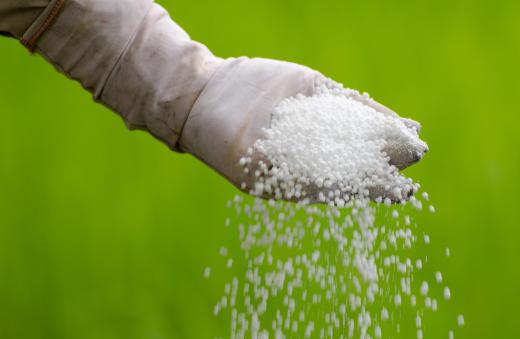What is Nitrogen Fixing?
 Mary McMahon
Mary McMahon
Nitrogen fixing, also known as nitrogen fixation, is a process through which atmospheric nitrogen is converted into compounds which are usable by plants. It is an important part of the nitrogen cycle, which contributes to the growth of plants all over the world, and therefore to the success of organisms like animals and people. In addition to occurring in nature, nitrogen fixing can also be accomplished chemically for industrial purposes.
Atmospheric nitrogen cannot be utilized by plants, although they need nitrogen to thrive. Bacteria, however, can harvest nitrogen and convert it to useful compounds, by producing ammonia compounds which are converted into nitrates by other microorganisms in a process known as ammonification and nitrification. These organisms can be found in soil and water, contributing to the nitrogen cycle constantly all over the world.

When plants intake nitrates, they use them for energy, growing so that they can mature and produce seeds to grow into new plants. Other organisms can eat the plants, thereby benefiting from the nitrogen fixing accomplished by bacteria, and when plants die, they decay into the soil, releasing compounds which contain nitrogen and can be used by other plants. Once plants get going, in other words, they can set up a system which will perpetuate as older plants die to make room for younger ones, sharing fertilizer as they break down.

Some plants engage in what is known as symbiotic nitrogen fixation. This occurs when a plant has a symbiotic relationship with a bacterium which lives on or in the plant. Some type of legumes, such as beans and peas, are famous for their symbiotic nitrogen fixing, and these plants are often referred to as "nitrogen fixers" in a reference to that. They may be planted on soil which is recovering from overutilization to help the soil rebuild its supply of nitrates and other useful compounds. Gardeners can also apply compounds which are designed to stimulate nitrogen fixing to poor soil to help plants get established.
Industrially, nitrogen fixing is usually accomplished at high temperatures and pressures to make compounds used in fertilizers, explosives, and other products. The ability to manufacture nitrogen products industrially is critical to the success of many human endeavors, from agriculture to mining. Nitrogen fixation also occurs as a result of natural processes such as lightning and combustion, although the vast majority of nitrogen fixing in nature is the result of microorganisms such as cyanobacteria, which live in, with, or near a variety of plants and organisms like fungi.
AS FEATURED ON:
AS FEATURED ON:












Discussion Comments
I'd be interested to see a list of more nitrogen fixing plants. I grew up in Iowa where farming is huge. I know soybeans are legumes, and when you pull them up, they have little balls on the roots. I wonder if those are related to nitrogen fixation?
@Izzy78 - Yes, there are quite a few trees than can fix N2 gas from the atmosphere and turn it into ammonia (NH3) or ammonium (NH4).
Like the article mentions, legumes can often fix nitrogen. Probably the most popular is black locust. Another oddball tree is red alder. It isn't a legume, but has developed a symbiosis to fix nitrogen.
Black locust, especially, is popular for surface mine reclamation because the soil is usually degraded, and needs as much nitrogen as possible to help other species of trees grow.
I think I'm having a flashback to my days in soils class. I know a lot of the nitrogen ends up getting leached away by water or else is trapped in the soil where plants never get a chance to use it. That's why farmers have to put nitrogen back into the soil each year. Then we end up with the problem of runoff.
Aren't there certain types of nitrogen fixing trees too?
Post your comments